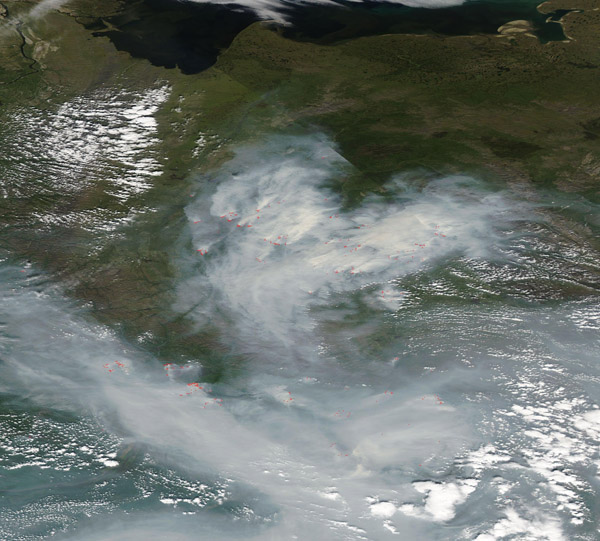Images
August 14, 2020 - Fires in Russia
Tweet
Abnormally warm temperatures have spawned an intense fire season in eastern Siberia in the summer of 2020. Satellite data show that fires have been more abundant, more widespread, and produced more carbon emissions than recent seasons.
On August 5, the Moderate Resolution Imaging Spectroradiometer (MODIS) on board NASA’s Aqua satellite acquired a true-color image of heavy smoke shrouding parts of Siberia. This includes the Sakha Republic, one of the most active fire regions in Siberia this summer. As of August 6, approximately 19 fires were burning in the Republic and in late July smoke from this area reached Alaska.
Estimates show that around half of the fires in Arctic Russia this year are burning through areas with peat soil—decomposed organic matter that is a large natural carbon source. Warm temperatures (such as the record-breaking heatwave in June) can thaw and dry frozen peatlands, making them highly flammable. Peat fires can burn longer than forest fires and release vast amounts of carbon into the atmosphere. They also release methane, which is a more potent greenhouse gas that carbon dioxide.
Image Facts
Satellite:
Aqua
Date Acquired: 8/5/2020
Resolutions:
1km (331.9 KB), 500m (1.1 MB), 250m (3.1 MB)
Bands Used: 1,4,3
Image Credit:
MODIS Land Rapid Response Team, NASA GSFC
Tweet
Abnormally warm temperatures have spawned an intense fire season in eastern Siberia in the summer of 2020. Satellite data show that fires have been more abundant, more widespread, and produced more carbon emissions than recent seasons.
On August 5, the Moderate Resolution Imaging Spectroradiometer (MODIS) on board NASA’s Aqua satellite acquired a true-color image of heavy smoke shrouding parts of Siberia. This includes the Sakha Republic, one of the most active fire regions in Siberia this summer. As of August 6, approximately 19 fires were burning in the Republic and in late July smoke from this area reached Alaska.
Estimates show that around half of the fires in Arctic Russia this year are burning through areas with peat soil—decomposed organic matter that is a large natural carbon source. Warm temperatures (such as the record-breaking heatwave in June) can thaw and dry frozen peatlands, making them highly flammable. Peat fires can burn longer than forest fires and release vast amounts of carbon into the atmosphere. They also release methane, which is a more potent greenhouse gas that carbon dioxide.
Image Facts
Satellite:
Aqua
Date Acquired: 8/5/2020
Resolutions:
1km (331.9 KB), 500m (1.1 MB), 250m (3.1 MB)
Bands Used: 1,4,3
Image Credit:
MODIS Land Rapid Response Team, NASA GSFC




